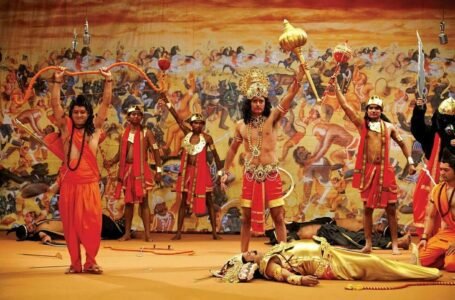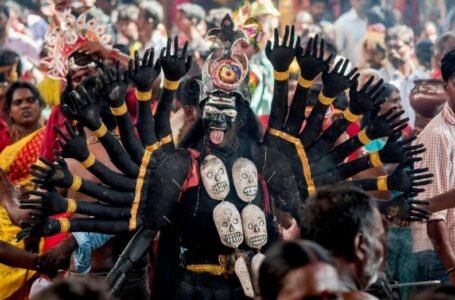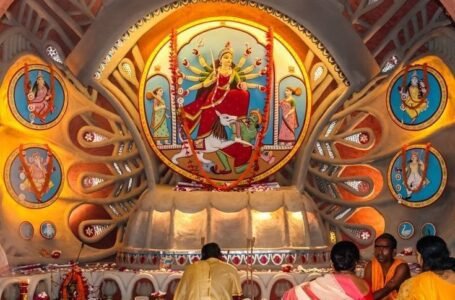Khandoba Temple of Jejuri: The Golden Hill of Devotion and Warrior Spirit

-Arushi Kastwar
In the still town of Jejuri, nestled among Maharashtra’s Sahyadri hills, there’s a temple more than just a stone and historical monument—it is a temple that shines with living color, true devotion, and centuries of tradition. The Khandoba Temple of Jejuri is no mere religious pilgrimage site—it’s a spectacle of faith. Veiled in yellow turmeric clouds, it throbs with life during festivals, incantations, and a kind of spiritual ecstasy that is difficult to find elsewhere. Khandoba, or Malhari Martand, is not only a god here; he is a warrior, a husband, a guardian, and above all, the intensely personal god of the people.
Khandoba: The Deity of Many Faces
Khandoba is a local god of Maharashtra, who is worshipped mainly by the Dhangar, Kunbi, and Maratha people. He is considered to be an incarnation of Lord Shiva, usually identified with Bhairava and Martanda Bhairava. But in contrast to the mainstream Shiva usually visualized in cosmic silence or peaceful meditation, Khandoba is active, fierce, and grounded in the mundane world of his followers. He rides a horse, wields weapons, and vanquishes demons. He is married to women from various social classes and communities, signifying openness. In more ways than one, he is a people’s god—complex, passionate, and so vividly human.
The Myth and Legend: Slaying of the Demons
The origin of the Khandoba cult goes back to the myth of his fight against two demons—Malla and Mani. The demons were oppressing the earth, and the gods prayed to Lord Shiva for relief. Shiva, moved by their request, assumed the guise of Khandoba and emerged as a formidable warrior. Sitting on horseback and holding an implement known as the Bhandara, he fought with tremendous fury against the demons. Malla was killed, and Mani, prior to his death, yielded and presented a white horse to Khandoba and asked for mercy. This myth is not only core to the temple’s mythology but also performed in different forms during temple celebrations.
A Temple on a Hill: A Climb of Faith
The Khandoba Temple sits at the top of a hill in Jejuri, some 50 kilometers southeast of Pune. Pilgrims climb around 200–300 steps to access the temple complex. The climb is not merely physical—it’s spiritually profound. With each step upwards, the lezim music, the devotional chants, and the vendors’ shouts selling turmeric and sweets reverberate. The yellow powder of turmeric—bhandara, they call it in these parts—coats everything and everyone. By the time one reaches the temple gates, the material world seems to change, colored with yellow devotion.
Architectural Grandeur and Simplicity
The temple’s architecture combines the old with the changing. Constructed largely of basalt rock, the complex consists of courtyards, pillared halls (mandapas), temples, and gateways. Though imposing, the temple architecture is plain and unostentatious. The sanctum sanctorum contains Khandoba’s idol—a mustachioed warrior-like deity with a sword and riding a horse. It’s not only the idol but also the experience that comes with it—the rhythmic drumming of the drums, the blowing of the conch shells, and the yellow powder wafting in the air—that brings an aura of divine intensity.
Turmeric: The Divine Color
Perhaps the most recognizable feature of the Khandoba Temple is the application of turmeric. Pilgrims have baskets full of it, toss it in the air, apply it on themselves, and present it to the god. Turmeric in Indian culture is a sacred material that embodies purity, prosperity, and sanctity. At Jejuri, it turns into the language of devotion that is physical and visual. The temple complex becomes golden during festivals. It’s not a ritual—don’t call it a ritual—it’s a full-bodied celebration, an act of surrender and ecstasy in participation. People emerge from the temple soaking yellow, smiling and beaming, as if divinity has touched them.
A Marriage that Defines Culture
Khandoba has several consorts whom he marries, but his marriages to Mhalsa, a high-caste lady from the Newar group, and Banai, a Dhangar shepherd girl, have profound social as well as religious meaning. Mhalsa symbolizes orthodoxy, ritualism, and order, and Banai, spontaneity, folk beliefs, and non-Brahmanic religion. Both consorts have been typically perceived as exemplifying the double streams of devotion—scriptural and emotional, orderly and natural-flowing.
Khandoba’s wedding to Banai particularly is notable. It breaks the shackles of caste and tradition. Through it, the downtrodden groups of Maharashtra find their presence and acceptance. It’s a sacred wedding with earthly consequences—overturning the strict social conventions and proclaiming the universality of the god.
Festival of Champa Shashti: A Time of Divine Fury and Joy
One of the most awaited festivals at Jejuri is Champa Shashti, celebrated in the month of Margashirsha (November–December). The six-day celebration culminates on the sixth day, believed to be the day when Khandoba defeated the demons Malla and Mani. The entire temple erupts in a yellow storm as devotees shower turmeric and chant Khandoba’s name in unison. The air becomes thick with devotion, music, and energy. It brings in hundreds of thousands of the devout from all over Maharashtra, even neighboring states.
There are special rituals, palakhi processions, music, dancing, and displays of martial arts. The deity is given regal treatment, and his sacred energy is unleashed by means of processions and ritual displays of arms. It’s an experiential assault of the purest form.
The Folk and the Divine: Cultural Significance
Khandoba is maybe one of the most intriguing gods of Indian mythology because he mixes the folk with the divine. He is at the same time a guardian of shepherds and farmers and a god worshipped in elaborate temples. His legend is sung in oviyas, abhangas, and folk songs. Bards traveling and minstrels roaming bring his legend alive in rural Maharashtra. His iconography incorporates motifs from tribal cultures, and yet he takes his place among upper-class deities.
His impact extends beyond religion. He is mentioned in Marathi literature, folklore, theatre, and local cinema. His cult is a cultural identity in itself—transcending caste, community, and creed in a society often divided by them.
The Symbolism of Weapons and Horse
Khandoba is typically shown holding a sword or khadga and a trident, astride a white horse. These symbols aren’t accessories—they’re full of symbolism. The horse symbolizes energy and the ability to move forward, and the weapons symbolize justice and protection. The war god is always ready to destroy evil, yet kind to his followers. His image inspires awe and love—a duality that reflects the human experience of fear and faith.
Ritual Procedures and Offerings
The rituals at the Jejuri temple are colorful and participatory. The turmeric, coconuts, sugar, and flowers are offered by devotees. Symbolic weapons or small horses in silver or clay are offered by some. Vows are taken before Khandoba by many—to settle quarrels, for recovery from disease, or for marriage partners—and these are returned with gratitude when the desires have been granted. Animal sacrifice used to be practiced but is now mostly symbolic or substituted with vegetarian items.
The priests, or Guravs, are part of certain hereditary clans and have been responsible for keeping alive the temple’s traditions and rituals from generation to generation.
Women and Devotion: A Deep Connection
Women play a crucial role in the devotional life of the Khandoba temple. From singing oviyas to taking part in turmeric rituals, they express devotion with deep personal intensity. For many rural women, Khandoba is more than a god—he is a friend, a protector, even a secret confidant. The temple provides a space where faith is physical, emotional, and healing.
Jejuri in Literature and Art
Jejuri has influenced artists and writers in equal measure. The most famous literary tribute is probably Arun Kolatkar’s Jejuri, a volume of English poems that map the prosaic and mystical sides of the temple. The poems bare the romanticism and offer a gritty, contemporary perception of spirituality, and the way profound faith can coexist with doubt, irony, and worldly life.
The image of the turmeric-colored pillars, the temple monkeys, crumbling stairs, and pious faces get integrated in literature and visual arts. The raw energy of the site has attracted photographers, filmmakers, as well as painters.
Economic and Social Impact
The temple is Jejuri town’s lifeline. Pilgrimage tourism employs hundreds—priests and vendors, hoteliers and rickshaw pullers. The price of turmeric goes through the roof during festivals, affecting the local farming industry. Handicrafts, religious gear, and sweets are part of a thriving micro-economy built around the temple.
The temple also finances schools, health projects, and community kitchens. It becomes an example of how religion can not only elevate spirits but elevate lives.
Accessibility and Contemporary Facilities
In recent times, there have been attempts on the part of the Maharashtra government and temple committees to modernize facilities without demarcating the sanctity of the area. There have been enhanced staircases, railings, sanitation facilities, and crowd management systems installed. For the elderly, disabled, or otherwise, vehicles can drive pilgrims near the hilltop, which assures accessibility.
Even after modernization, the temple has not lost its rustic beauty. One still hears the ring of brass bells, catches the scent of burning incense, and witnesses flocks of devotees going barefoot up the hill in plain attire with turmeric in hand.
Jejuri Beyond the Temple
Though the temple is the draw, Jejuri town has more to provide. The hill views are panoramic—green fields, blue sky, distant hills. Foodies are drawn to local fare, particularly the puran poli and spicy munchies. Brass lamps, devotional literature, and turmeric sold in handcrafted pouches can be found in traditional markets.
For culture lovers and photographers, Jejuri provides unlimited frames—kids with turmeric-stained faces, women lighting lamps, men beating dhol-tasha, and yellow-robed sadhus chanting shlokas. Every moment is a tale.
Conclusion: Where Faith Turns to Gold
The Khandoba Temple of Jejuri is not a religious monument alone. It is a pulsating, living embodiment of Maharashtra’s cultural conscience. It is where mythology turns into religion, where turmeric turns divine, and where individuals discover god not in quietude but in revelry.
It is a site where history, faith, and culture converge at the summit of a hill, covered in yellow dust and illuminated by the eternal lamps. Jejuri is not a pilgrimage. It is an immersion in the collective memory, ritual feeling, and eternal spiritual force. And once you have been touched by that cloud of gold turmeric, you have within you a piece of Jejuri forever.


